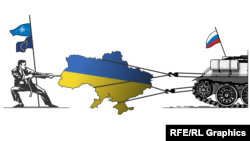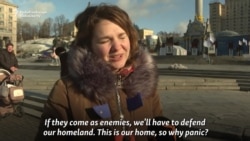Since the annexation of Crimea by Russia in 2014, NATO has substantially increased its defense posture on the alliance’s eastern flank: it established four multinational battle groups in Estonia, Latvia, Lithuania, and Poland, and it expanded its air-policing capabilities in the Baltic states and Eastern Europe to intercept Russian aircraft breaching the airspace of member states.
Led by the United States, the United Kingdom, Canada, and Germany, these units back up the idea that an attack on any NATO ally would be considered an attack on the whole alliance. Each unit also receives contributions from other NATO members.
Ukraine is not a NATO member, but it has been a "partner country" since 2008 – the year it applied for a Membership Action Plan. That means that it may be allowed to join the alliance in the future. Russia wants assurances from Western powers that this will never happen.
As Russia has amassed over 100,000 troops near the border with Ukraine, some NATO allies have been sending military aid to Kyiv. U.S. and EU leaders have also undertaken diplomatic efforts to soothe tensions with Moscow, but some of Russia’s geopolitical demands concerning NATO’s expansion to former Soviet states are considered “nonstarters.”
How NATO Members And The EU Are Supporting Ukraine
The European Union has been providing loans and grants to support Ukraine since 2014 – the year Russia occupied and annexed Crimea – and on February 1, 2022, it announced further financial aid of some 1.2 billion euros ($1.35 billion) to help the country during the current crisis.
Canada has announced financial aid of $340 million for immediate support to Ukraine and the extension and expansion of Operation UNIFIER, the Canadian armed forces’ military-training and capacity-building mission in Ukraine.
The United States has deployed 2,000 U.S.-based troops to Germany and Poland, relocated 1,000 U.S. soldiers from Germany to Romania, and provided a military aid package of $200 million, including 300 Javelin anti-tank missiles and 79 tons of security assistance.
Denmark sent a frigate to the Baltic Sea, and four F-16 fighter jets to Lithuania in support of NATO’s long-standing air-policing mission in the region.
Latvia and Lithuania are shipping Stinger anti-aircraft missiles after receiving approval from Washington to transfer the weapons.
The Netherlands will be sending two F-35 fighter jets to Bulgaria in April to support NATO’s air-policing activities in the region and is putting a ship and land-based units on standby for NATO’s Response Force.
Spain is sending ships to join NATO naval forces and is considering sending fighter jets to Bulgaria.
Estonia is sending Javelin anti-tank missiles to Ukraine.
Turkey has already shipped anti-tank drones to Ukraine.
The United Kingdom has sent anti-tank missiles to Ukraine, as well as troops to train Ukrainians in their use.
Germany is sending a field hospital to Estonia and it has announced that it will deploy 350 troops to Lithuania to reinforce a NATO battle group there.
Poland’s government approved the sending of air-defense weapons, ammunition, and drones to the Ukrainian armed forces.
The Czech Republic provided Ukraine with artillery rounds in January with the transfer of 4,006 152-millimeter shells.
What Do Europeans Say About A Possible Russian Invasion Of Ukraine?
While there has been much talk that governments in Europe are divided over the conflict, a January 2022 report by the European Council on Foreign Relations (ECFR) reveals that European citizens believe Russia's invasion of Ukraine could bring up some serious security issues for Europe in terms of energy and immigration, for instance. They also believe that Europe has a duty to respond to the crisis, with a majority supporting a NATO and EU response.
What Russians Are Saying
A survey taken by the Levada Center in April 2021 revealed that there is little enthusiasm for a military intervention among members of Russia’s modern, urban society.
The view that it is necessary to take part in the conflict in case of an outbreak of hostilities is most popular among older groups. This view is much less popular among younger groups, as shown in the chart below.
What Ukrainians Are Saying
Many Ukrainians believe Russia is “softening” their country before actually invading by using Soviet-era tactics to try to destabilize the economy, generate civil disturbances and smear campaigns, terror and cyberattacks – like the one on January 14 that took down more than a dozen of Ukraine's government websites – and even assassinations.
There is a belief that Russia will only be in a position to successfully invade when Ukraine is on the verge of becoming a failed state.













